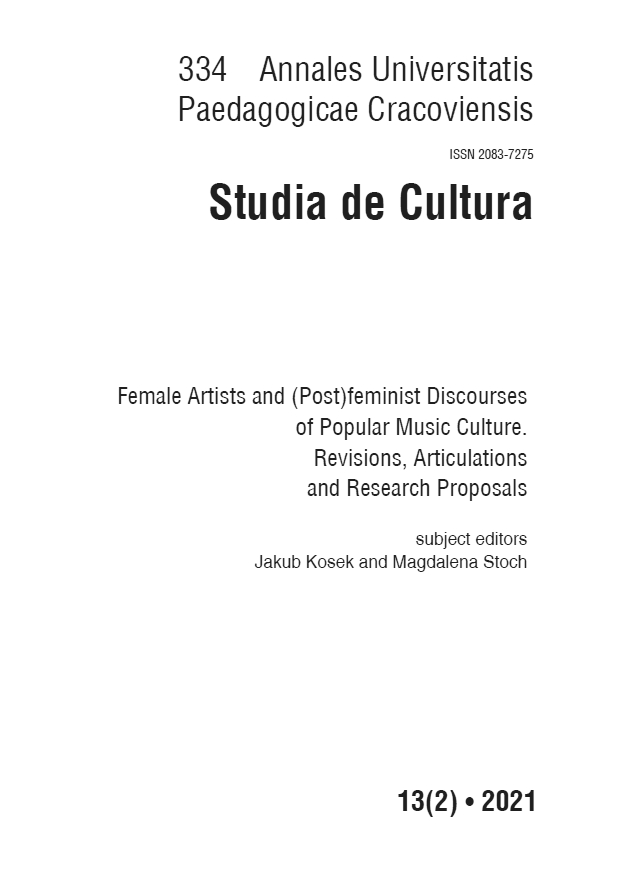Abstract
The music media have constructed the identity of groupies as sexual and passive objects, submissive, inauthentic consumers of music. The stereotype, although still present in popular culture, is criticized by both the interested parties and rock artists. This article is an attempt to discuss the role that groupies played in the creation of the myth and character of the rock god, while taking into account the preconceived assumptions held by the popular media. Narratives of groupies’ participation in the emerging rock and metal scene have also been included as the ones which created a male rock musician identity: wild, aggressive and powerful. The basis for the discussion of groupies and their role in building identity in the context of rock music is the result of a deep, rhetorical analysis of groupies’ biographies, press materials, films, scientific literature and own research.
References
Ayres Chris, Osbourne Ozzy. 2014. Ja, Ozzy. Dariusz Kopaciński (transl.). Czerwonak.
View in Google Scholar
Bozza Anthony, Lee Tommy. 2004. Tommyland. New York.
View in Google Scholar
Burks John, Hopkins Jerry. 1970. Groupies and Other Girls: A Rolling Stone Special Report. New York.
View in Google Scholar
Cline Cheryl. 1992. Essays from Bitch: The Women’s Newsletter with Bite. In: The Adoring Audience: Fan Culture and Popular Media. Lisa A. Lewis (ed.) London.
View in Google Scholar
Davis Steven. 2008. Młot bogów: Saga Led Zeppelin. Marta Szelichowska-Kiziniewicz (transl.). Czerwonak.
View in Google Scholar
Davies Helen. 2001. “All rock and roll is homosocial: The representation of women in the British rock music press”. Popular Music no. 20(3).
View in Google Scholar
Des Barres Pamela. 1987. I’m With the Band: Confessions of a Groupie. New York.
View in Google Scholar
Des Barres Pamela. 1992. Take Another Little Piece of My Heart: A Groupie Grows Up. New York.
View in Google Scholar
Des Barres Pamela. 2007. Let’s Spend the Night Together. Chicago.
View in Google Scholar
Frith Simon, Horne Howard. 1987. Art into Pop. New York.
View in Google Scholar
Frith Simon, McRobbie Angela. 1978. Rock and Sexuality. London.
View in Google Scholar
Forrest Rebecca. 2010. Mud shark: Groupies and the construction of the heavy metal rock God. In: The Metal Void: First Gatherings. Niall W.R. Scott, Imke Von Helden (eds.). Oxford.
View in Google Scholar
Forsyth Craig J., Thompson Carol Y. 2007. “Helpmates of the rodeo: Fans, wives and groupies”. Journal of Sports and Social Issues no. 31(4).
View in Google Scholar
Hill Rosemary L. 2014. “Reconceptualising Hard Rock and Metal Fans as a Group: Imaginary Community”. International Journal of Community Music no. 7(2).
View in Google Scholar
Karbownik Karolina. 2017. “Seks, śmierć i Steel Panther”. Mystic Art no. 1(66).
View in Google Scholar
O’Reilly Daragh, Larsen Gretchen, Kubacki Krzysztof. 2013. Music, Markets and Consumption. Oxford.
View in Google Scholar
Rhodes Lisa. 2005. Electric Ladyland: Women and Rock Culture. Philadelphia.
View in Google Scholar
Scharrf Virginia. 2003. Twenty Thousand Roads. Women, Movement and the West. Toronto.
View in Google Scholar
Shepherd John. 1989. Music and male hegemony. In: Music and Society. The Politics of Composition, Performance and Reception. Richard Leppert, Susan McClary (eds.). Cambridge. 152–173.
View in Google Scholar
Sixx Nikki, Mars Mick, Neil Vince, Lee Tommy, Strauss Neil. 2010. Mötley Crüe. Brud. Michał Kapuściarz (transl). Poznań.
View in Google Scholar
Straw Will. 1984. “Characterizing Rock Music Culture: The Case of Heavy Metal”. Canadian University Music Review no. 5(5).
View in Google Scholar
Warwick, J. 2007. “Book review of «Electric Ladyland: Women and Rock Culture» by Lisa L. Rhodes”. American Studies no. 48(1). Philadelphia.
View in Google Scholar
Weinstein Deena. 2000. Heavy Metal and Its Culture. Boston.
View in Google Scholar
Whiteley Sheila. 1997. Sexing the Groove: Popular Music and Gender. New York.
View in Google Scholar
Netography:
View in Google Scholar
Hilburn Roger. 1969. “Groupie’ Therapy on Rock Scene”. Los Angeles Times. https://latimes.newspapers.com/ (access: 14.09.2020).
View in Google Scholar
Karbownik Karolina, Annie C. Laviour. „Być jak groupie”. Rock Axxess (15-16) https://issuu.com/rockaxxess/docs/rock_axxess_15-16 (access: 23.08.2020).
View in Google Scholar
Orloff Kathy 1970. “New Music, New Morality and the Groupie Movement”. Los Angeles Times. https://latimes.newspapers.com/ (access: 14.09.2020).
View in Google Scholar
Thomas Kevin. 1970. “Groupies. Details Rock Phenomenon” Los Angeles Times https://latimes.newspapers.com/ (access: 14.09.2020).
View in Google Scholar
Torgeson Dial. 1968. “The New Morality: Is It New or Just in the Open” Los Angeles Times. https://latimes.newspapers.com/ (access: 14.09.2020).
View in Google Scholar
Filmography:
View in Google Scholar
Crowe Cameron. 2000. “Almost Famous”, USA.
View in Google Scholar
Dorfman Rob, Nebard Peter. 1970. “Groupies”, USA.
View in Google Scholar

This work is licensed under a Creative Commons Attribution-NonCommercial 4.0 International License.

